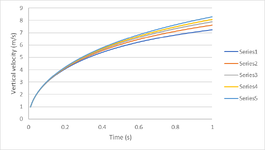- Thread Starter
- #21
First thing to do is establish that an object with higher density of mass will drop fast than an object of lighter density. Since I don't have a bowling ball and a feather handy, I use and ink pen and a piece of paper. Dropped at the same time the pen will hit the floor sooner than the paper. With that we now know the heavy end of the arrow will drop faster than the light end. Drop an arrow from a flat position and the heavy end will hit the ground before the light end. It will be hard to see the difference with the eye, but a half inch is a lot when it comes to flight of a broadhead. The half inch is what I estimated it was when I drop tested my arrow. When in flight, momentum wants to keep the arrow going in a straight line, while gravity is pulling it down. With the point end now slightly lower than the tail due to gravity, both the broadhead and the fletching are catching air and driving the arrow down faster than gravity alone. To test this stick your hand out the window of a car traveling at highway speed. When your hand and arm are flat with the direction of travel, it takes very little effort to hold it straight. All you have to do, is overcome the force of gravity pulling on your arm down. Now point your hand and arm down to see how much force the air applies to your arm. The force of the air can be significantly greater than the force of gravity. This has been a great conversation to have with everyone . I hope it gets people thinking and maybe a qualified engineer of aerodynamics will chime in and help.


